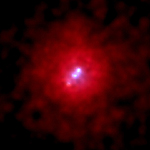November 16, 1999
CXC PR: 99-09
The NASA Chandra X-ray Observatory image of the distant galaxy 3C295 shows an explosive galaxy enveloped by a vast cloud of fifty million degree gas. The gas cloud, which is visible only with an X-ray telescope, contains more than a hundred galaxies and enough material to make a thousand more. The galaxies are too cool to be visible in X rays. Roughly two million light years in diameter, the cloud and its cluster of galaxies are among the most massive objects in the universe. It is so distant that we see it as it was five billion years ago.
3C295 appears optically as a giant, basketball-shaped galaxy that contains several time the mass of our Milky Way galaxy. Astronomers think that it has grown over the eons as mass from the colossal gas cloud cooled and settled onto the galaxy.
The bright X-ray knots visible for the first time in the Chandra image are probably an indirect result of this dumping of gas onto 3C295. The central knot coincides with the center of the galaxy; these X rays are most likely due to matter falling into a supermassive black hole. The upper and lower knots are in the same location as two large lobes of radio emission. The distance from the top to the bottom knot is about 100,000 light years, comparable to the diameter of our Milky Way galaxy. The total X-ray power in the knots is three times greater than all the power produced by our galaxy.
X-ray and radio observations indicate that 3C295 was wracked by an awesome explosion that occurred about a million years ago in the center of the galaxy. Chandra observations suggest that the explosion is related to an excess of matter falling into the massive black hole. In much the same way that a torrent of water pouring down a drain can produce a back pressure if the flow is more than the drain can handle, the enormous energy released by too much matter flowing into a black hole could trigger an explosion. Great quantities of matter and energy would be hurled back into the surrounding gas cloud, in a powerful payback for eons of being dumped on by a cosmic bully.
The Chandra image was taken with the Advanced CCD Imaging Spectrometer (ACIS) on August 30, 1999 in an observation that lasted about six hours. ACIS was built by Penn State Univ. and MIT. The image has been colorized to highlight the intense X-radiation from the X-ray knots in 3C295.
To follow Chandra's progress, visit the Chandra site at:
NASA's Marshall Space Flight Center in Huntsville, AL, manages the Chandra program. TRW, Inc., Redondo Beach, CA, is the prime contractor for the spacecraft. The Smithsonian's Chandra X-ray Center controls science and flight operations from Cambridge, MA.
High resolution digital versions of the X-ray image (JPG, 300 dpi TIFF) and other information associated with this release are available on the Internet at:
NASA TV on the web



